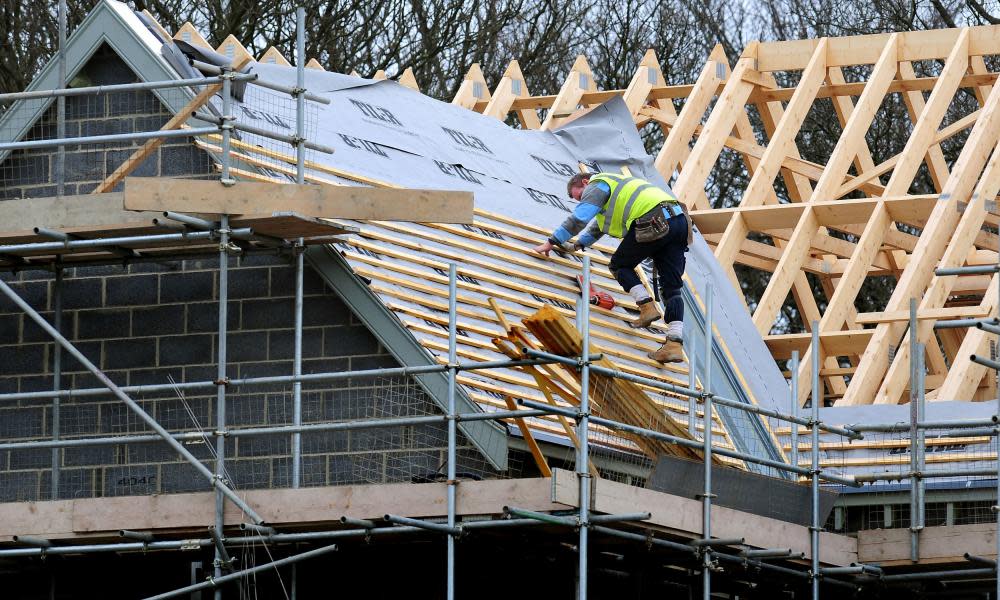At least one-tenth of Tory donations since 2010 are from property industry

At least one-tenth of the money donated to the Conservative party and its MPs since 2010 has come from property developers, real estate tycoons and others connected to the construction industry, an exclusive Guardian analysis reveals.
Meanwhile, housebuilders and property developers have benefited by billions of pounds from delays to low-carbon building regulations in the past eight years. The delays mean homeowners and taxpayers will have to pay tens of billions of pounds to bring newly built homes up to low-carbon standards, and have resulted in years of unnecessarily high greenhouse gas emissions, and higher energy bills for residents.
The government is to implement fresh delays to green regulations, after the prime minister, Rishi Sunak, announced a rollback of net zero policies last month that will benefit housebuilders still further.
The Guardian analysis found housebuilders, developers, and real estate tycoons have donated almost £40m to the Tories since 2010, when the Conservative and Liberal Democrat coalition took office.
The construction sector – including some companies that are not Tory party donors – has saved at least £15bn since 2015 by building homes to old, high-carbon standards, without solar panels and batteries, heat pumps and effective insulation.
The cost of remedying these omissions in order to reach the UK’s target of net zero greenhouse gas emissions by 2050, if left to individual homeowners or taxpayers, would reach £45bn, according to the analysis.
Since 2015, the Conservative government has made several decisions that have saved money for housebuilders while running counter to the UK’s green targets. These decisions include:
Refusing to require new homes to be built with heat pumps instead of gas boilers, resulting in most new homes being connected to the gas grid.
Refusing to mandate that new homes are built with solar panels.
Delaying tougher building regulations on insulation.
Delaying a “future homes standard” to ensure new homes are net zero carbon.
Continuing to back hydrogen for home heating, after experts warned it would be expensive and impractical.
Attempting to scrap nutrient regulations that would force housebuilders to clean up watercourses.
Juliet Phillips, a senior policy adviser at the E3G climate thinktank, said: “Several key environmental regulations have been thrown into the regulatory bonfire. This includes delays to new laws that would have required housing developers to boost biodiversity and improve local wildlife habitats. There are concerns that even more regulations could get caught in the crossfire of the highly politicised net zero culture war. Among these is the requirement for new homes to be highly efficient and installed with a heat pump from 2025.”
She said delays had already added to costs for householders and taxpayers. “Delays to the future homes standard hit homeowners twice: first, through higher energy bills associated with inefficient buildings; and second, through costly retrofits needed to make homes net zero ready. Industry, investors and consumers urgently require reassurance that the standard will be implemented as planned from 2025,” she said.
“It’s a false economy to think that delaying the introduction of the standard will benefit the UK. Instead, long-term policy certainty will spur investment in green skills and supply chains. We urge the government to move ahead with the planned consultation without further delay.”
Building a new home to low-carbon standards is cheaper than retrofitting it. Green experts approached by the Guardian estimated the building cost for installing items such as air source heat pumps, solar panels and batteries, and insulation, would be about £8,500. However, for a householder to retrofit a dwelling to the same standards would cost about £33,000.
The cost difference is because developers can integrate the technologies into the building design and fabric during its construction, while also benefiting from large economies of scale. It is also easier to install some equipment, such as ground source heat pumps which require extensive trenches, or insulation that is fitted into walls, from the outset than to do so later.
David Cowdrey, the director of external affairs at the MCS Charitable Foundation, which works to promote renewable energy, said: “Contrary to some MPs’ claims, research shows that people overwhelmingly want renewables like solar panels, heat pumps and battery storage to make sure their homes are affordable to keep warm and comfortable. It should be a no-brainer to put renewable energy in all homes, when doing so is cheap and efficient, and does not rely on expensive gas for heating.”
In 2015, soon after the Conservatives won the general election, the government scrapped regulations that would have forced the construction sector to ensure all new homes were low carbon. Since then, about 1.5m new homes have been built, the vast majority of which would not meet such standards.
A Guardian analysis of Electoral Commission data found the Conservative party had received £27.1m in donations from real estate, construction and development companies since 2010.
The party received a further £11.2m from individuals who sit on the boards of property companies or have large real estate interests. Separately, Tory MPs received more than £850,000 in gifts and donations from companies and individuals connected to the construction industry in the same period.
The £39m in combined party and MP donations to the Conservatives from property interests is 13 times the £2.7m donated to the Labour party or its MPs in the same period: £2.3m from property companies, £401,000 from individuals and £271,000 to its MPs.
This £39m includes more than £2m in the past 18 months: the party received £1.9m in donations from property companies and £567,000 from individuals with links to them.
Countywide Developments – of which the property developer Tony Gallagher is director – has given £4.3m to the Conservative party since 2010, including £385,000 since January 2022.
John Bloor has donated £3.1m to the party since 2010 through his various companies.
Other companies that have donated large amounts include Bridgemere UK, which provides development finance for UK housebuilders and developers, and has donated £1.6m to the Conservatives since 2019. Thakeham Homes has donated £966,440 since 2017, £250,000 of it in 2022.
Individuals who have donated large amounts include the real estate investor Roger Orf (£628,000 since 2013), the luxury developer Nicholas Candy (£271,000 since 2020), and the real estate magnate Laurence S Geller (£444,000 since 2018).

A Conservative party spokesperson said: “The prime minister has set out a practical route to achieving net zero that does not clobber households with higher rents and bills. We are still committed to meeting our net zero target by 2050.”
A government spokesperson said: “The future homes standard will deliver homes that are net zero ready. In 2021 we introduced an improvement in energy efficiency standards, meaning new homes being built now already produce significantly lower carbon emissions and have excellent levels of insulation. We are also supporting homeowners to get ready for net zero through a number of schemes, including the new Great British insulation scheme.”
A spokesperson from Bloor Homes said neither John Bloor, nor any representatives of the company, had held meetings with ministers or civil servants in the last three years, and the company had not asked the government to delay green regulations on new homes. They said: “Donations to the Conservative party ceased in March 2021. However, charitable donations in the last two years amounted to £14.49m. In addition, we have established a £50m non-recourse facility to the Crick Institute. All homes built conform to the building regulations applicable at the time they are built, and always have done.”
Countywide, through Gallagher Developments, did not respond to a request for comment.
A spokesperson for Bridgemere said: “Bridgemere has made several donations to the Conservative party but none over the last 18 months as it has become increasingly frustrated by the government’s total lack of progress on urgently required planning reforms. This lack of reform which ensures that fewer and fewer new homes are built every year is the major contributory factor to the current housing crisis. Any engagement with ministers [or] officials has been on this issue alone.”
The spokesperson added that Bridgemere’s Castle Green Homes had built about 500 new homes across north-west England and north Wales “to the latest environmental and energy efficiency standards. Castle Green is committed to further reducing its carbon footprint as rapidly as possible through the deployment of the latest technologies including air source heat pumps, solar panels, the extensive use of sustainable timber-framed construction and many other initiatives. ”
A spokesperson for Thakeham said: “Thakeham consistently pushes for higher environmental and sustainability standards in housebuilding and never for a reduction or delay in meeting our environmental obligations as we build the homes and communities needed. We are currently delivering net zero carbon affordable homes for a district council, and are starting a fully net zero carbon scheme this year. These schemes include solar panels, air source heat pumps, wastewater heat recovery, and are of timber-frame construction. Our net zero ambitions will see all Thakeham homes we build by 2025 be net zero in lifetime use, and carbon neutral in construction, having already been verified by Planet Mark in 2023 as a carbon-neutral business.”
Orf and Geller did not respond to a request for comment. A spokesperson for Candy said he concentrated on refurbishing prime properties, rather than standard new-build homes.
Methodology: to gather the list of property companies, the Guardian matched the company numbers of donors to industry codes from Companies House. This list was then supplemented by a list of the biggest developers.
The list of individuals was created by taking the names of company officers from Companies House, matching these to the names of individual donors, and supplementing it with the names of any well-known property tycoons. Only those matches with a high degree of confidence were included in the analysis, meaning the total amount donated from individuals with property interests could be higher.


